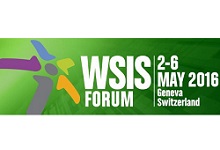Implementing best practices and addressing challenges
4 May 2016 12:15h
Event report
[Read more session reports and live updates from the WSIS Forum 2016.]
The workshop started with Mr Malcolm Johnson (ITU, DCG) highlighting the need to further develop the current ITU database. He stressed the need to link the database with other local or national databases, as this could be beneficial for the existing ITU database.
Ms Susan Teltscher (Head of the ICT Data and Statistics Division, ITU) highlighted the current done work, showcasing the flow of data and statistics for each country available in the ITU database. She emphasised the importance of having good data to set the right goals and targets. She advocated using consistent definitions and methodology, which is why the ITU uses data from official sources, such as ICT ministries.
Three trigger questions were delivered to the floor to be discussed at the different tables: How do we get to the essential data? Do we need access to statistics for stock taking? How can we improve data availability?
The audience had specific questions for Teltscher. One table asked how the ITU defined a computer, to which she answered that different devices require different skills so smartphones are not considered PCs. This resulted in a debate on the topic. Another table questioned how to get valid indicators and no contradictories, taking into account local conditions. Teltscher replied that the ITU tries to go for global indicators to facilitate comparisons across countries. Another table posted concerns about the differences in the definition of broadband access among different countries asking how a common set of indicators could be developed that would lead to a sector-per-sector track. In answer to both questions, Teltscher said that if countries had different definitions this would not impact the final reports, as the ITU collects data on broadband by speed and not by national definitions. She added that the ITU works in different areas, such as education, where various agencies collect the data in this specific sector. Finally, someone asked about the ongoing work to help achieve the infrastructure maturity. Teltscher replied that different indicators show the level of achievement regarding the different infrastructures, which can help us to see which stage we are at.
The overall feeling was that we need statistics to have transparency, better decision-making, better policy-making, and more investment. To improve at national level, the general feeling was that collaboration and cooperation, human resources development, and an open data platform are needed.
Mr Ben Addom (CTA) delivered a presentation about access to information regarding agriculture, focusing on achieving prosperity and reducing poverty. He presented a new database, App4Ag, as an ICT solution for agriculture, where information is available in order to make better use of existing resources.
Addom answered questions regarding geographical dispersion in terms of users and developers, gateways for investors, and implementation plans.
In response to a trigger question addressed to the tables, asking them how to better harness ICT for strengthening sustainable development, they suggested awareness raising, sharing by best practices and examples, sharing databases, education, capacity building, and human development.
by Adela Goberna
Related topics
Related event

